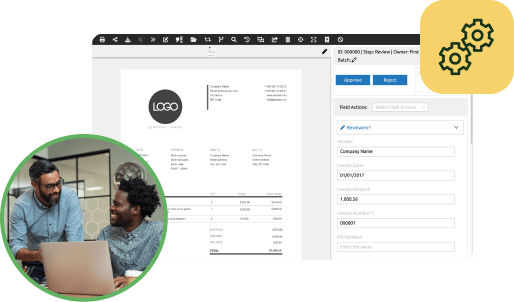
PairSoft
The strongest AP automation, document management, procurement, and fundraising automation platform for mid-market and enterprise companies with integrations to your ERP system.
View all posts by PairSoftPairSoft

Certain executive-level expectations accompany new software deployments, whether based in truth or not, and oftentimes the AP process remains a challenge.
The number one struggle that remains, even after a new financial system rolls out, is the bill chase. The problem is twofold: ensuring receipt of an invoice (and therefore recording the liability), and then figuring out where it is in the approvals or exception process (while trying to get it paid on time and within terms).
Even for the most organized accounts payable department with a strong purchasing process, manual bill processing means invoices still get lost somewhere along the line.
Since the buck stops with AP, it’s the AP clerk’s responsibility to know which invoices should have arrived at the organization, and who might have received them, and then to best attempt (read: harass) to procure the invoice from the desk or email inbox of whomever in the organization may have received it. Or call or email the vendor to try to get a copy. It’s not pretty.
Not only does AP become the nagging little brother of the organization, the work of chasing down a bill is a huge productivity killer. Instead of focusing on making timely smart cash flow decisions, the AP clerk is chasing down information just to get it into NetSuite.
So the bill has been located, but probably still has to go through a process for approval based on total amount or hierarchies, or on exception handling if any information is missing or inaccurate.
Even with a smart financial system like NetSuite, companies often still find themselves printing emailed invoices, and routing them around desks or interoffice mail for signatures or notes, gathering accompanying information along the way. This all takes time and continues to limit visibility into potential liability.
But the real blame game comes to AP when that invoice then ends up past due, a common occurrence due to the time it takes to track the bill down, get it approved, and then manually key the data into NetSuite.
AP has to know where the bodies (aka bills) are buried. Once an AP team member is trained to work within the company’s manual processes, maybe based on a set of vendors he or she is responsible for or a subset of all PO-based bills, that person becomes a necessary part of those processes.
By necessary, we mean that those processes cannot function without that person. In a manual environment, this process knowledge learned on the job usually exists only in the mind of the trained individual.
Enter a pandemic, maternity leave, a death in the family—an extended absence of any kind can now cause an entire subset of the AP process to collapse on itself. Without working knowledge of any one process, the rest of the AP department is left to pick up the pieces, which usually translates to begging for late payment forgiveness or apologizing for going to the wrong person for approvals.
In essence, they’re left to tread water until the employee with the process knowledge [hopefully] returns.
Though it may seem to be limited to the AP clerk’s day-to-day hassles, manual processes have impact all the way to the top of the organization. These standardization challenges limit visibility into outstanding liabilities, create cash flow or supply chain hiccups and introduce controls and compliance risks that all matter to the executive team—and the bottom line.
Help is just around the proverbial corner, however. The cost of manual bill processing challenges in NetSuite are well documented, and smart software suppliers have built upon years of invoice processing experience to provide just the tools needed to help your AP team. Here’s what you should look for in a solution:
Not only will you improve the AP team’s day-to-day work, but their standing in the organization, too.
Solutions like PairSoft offer all of the above and more for the NetSuite user. Visit our SuiteApp listing for more information and to hear firsthand about the AP automation solution from other NetSuite users.
Get a free demo to learn how our tailored workflows have boosted the AP performance for organizations of all sizes.


Many organizations start with manual receipt handling, fragmented card feeds and slow AP processes. Implement AI agents to auto-capture receipts, route approvals, enable punch-out buys and post to the ERP.
Result: faster batching, fewer errors and cost savings. “This saves us hours every month.”
Many organizations face slow, paper-heavy AP and fragmented procurement that waste time and inflate costs. AI Agents can automate approvals, PO matching and record sync to improve speed, accuracy and control. Client quote: “It freed up hours and made our process reliable.”
Operational drag and rising costs slow growth: teams waste time on manual tasks, misaligned priorities and opaque processes. AI Agents help automate routine work and coordinate actions across teams. “We’ve lost time to repeats and handoffs,” says a typical client.
Companies struggle with manual procurement, fragmented approvals, and costly integrations that slow growth and obscure spend. Our AI Agents streamline requisitions, POs, and invoice matching to cut manual work and improve visibility. “We were wasting time and missing insights,” says a client.

Many teams start with fragmented PO/AP systems, manual matching and delayed financial reporting. Deploying AI agents to automate PO checks, real-time encumbrance tracking and invoice matching reduces processing time and errors, delivering live budgets and faster closes. “Finally, we can see current balances and approve instantly.”
Many companies juggle growing invoice volumes and legacy systems. They struggle with manual processes, compliance gaps and limited headcount. Our AI Agents automate integrations, enforce rules and surface exceptions. The typical outcome: faster closes and measurable ROI. “We stopped chasing invoices.”